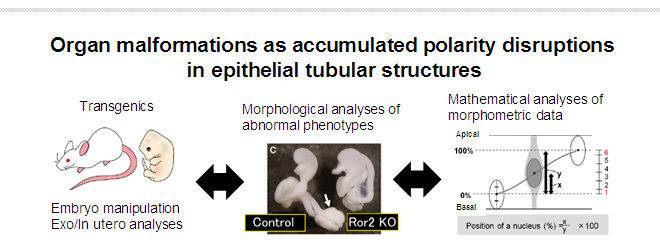|
HOME > Programmed research projects > Programmed research project 05
 Programmed research project 05Organ malformations as results of accumulated polarity disruptions in epithelial tubular structures during organogenesis and histogenesis
Purpose of the Research ProjectMalformations of organs are the abnormalities in position, shape, and/or size of the organs along the three-dimensional body axes as the results of accumulated abnormalities in various polarities at the cellular and tissue levels. These malformations can be considered as accumulations of abnormal elongation, polarization, and/or bifurcation in the tubular structure formation that are controlled by the polarity regulation through humoral factors and adhesions during the course of organ morphogenesis. However, the relationship between the abnormal cellular events and the organ malformation as the final result has not been analyzed from the standpoint of similarity and dissimilarity in the molecular mechanisms among various malformations of organs. In this project, we elucidate the mechanisms by which common and specific abnormalities in the polarity regulation in the epithelial tubular structures accumulate during the organogenesis and histogenesis periods and result in common and specific types of malformations among the organs. Content of the Research ProjectPatterns of malformations of organs that are composed of tubular structures are precisely analyzed in relation to the body axes at the cellular and tissue levels, and their morphological features are documented in detail. Thus, the relationships are analyzed between the macroscopic patterns of organ malformations and common and/or specific mechanisms of tubular structure formation through elongation, bifurcation, and polarization processes controlled by molecular mechanisms in the organs. Embryo manipulation, tissue and organ cultures are mainly used as experimental designs and mathematical methods are also employed for comprehensive analysis. Expected Research Achievements and Scientific SignificanceDetailed findings at the cellular level can be evaluated for the biological significance at the macroscopic level. Common and specific molecular mechanisms in the pattern formation of epithelial tubular structures at the cellular and tissue levels will be elucidated and the mechanisms to connect them to the pattern formation of macroscopic malformations will be clarified. Thus, the molecular basis will be obtained to understand the mechanisms of development and regeneration of epithelial tubular structures, and integral understanding will become possible on the mechanisms of disrupted organ morphogenesis from the cell to individual levels. Research achievement in this project will not only elucidate the molecular and cellular pathogenesis of organ malformations but also provide crucial information to realize the ideal form of organ regeneration where the regenerated organ will harmonize with the other organs in the recipient body.
|








